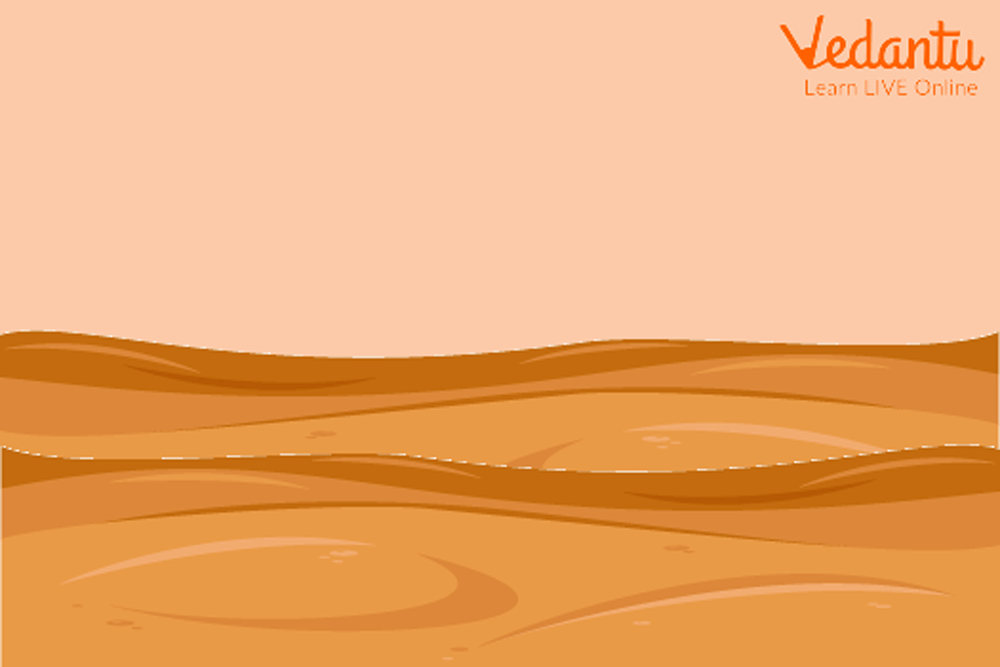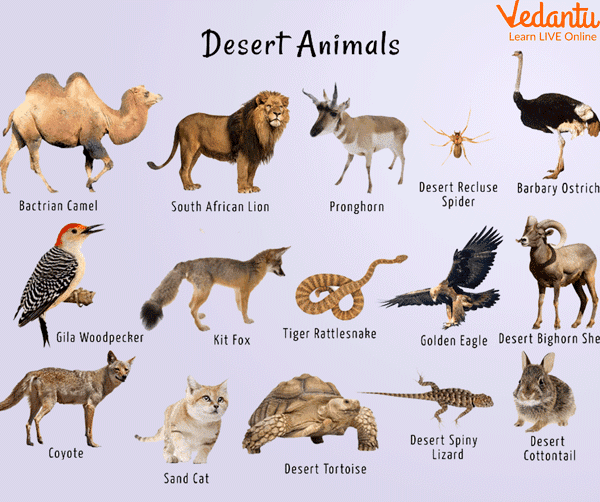




What Makes Deserts Unique? Climate, Plants, and Animals Explained
Have you seen a Desert? If yes, you must have seen something like this:

Desert
A dry, terrestrial ecosystem, the desert consists of habitats that receive very little rainfall. Deserts are extremely dry environments that are home to different plants and animals. The Desert biome covers about one-fifth of the Earth's surface and there is little water available for plants and other organisms.
There are four types of deserts :
Subtropical deserts
Coastal deserts
Cold winter deserts
Polar deserts
Because it is home to numerous creatures and serves as a source of sand, the Desert Biome is a crucial component of Earth. In many deserts, oil can be found. In the desert biome, spiders and insects live. Animals that live in deserts include lizards, toads, and camels. Plants are also grown such as Cacti, Trees, and Shrubs. We can say that the Desert is a place where almost no rain falls. So one can find variations on the surface of a desert.
Characteristics of Desert Biome
(Desert Facts for Kids)
1. Low Precipitation
The main characteristic of deserts is a shortage of precipitation that is no rainfall occurs even for years. In a Desert the rainfall is unpredictable.
2. Extremes of Temperature
During the day there is Scorching heat of the sun leading to high daytime temperature but during the night the temperature is very low. One can experience extremes of both heat and cold.
3. Slow Growing Plants
In Deserts the plants grow very slowly. The process of photosynthesis requires water but there is a lack of water, due to which plant growth is hindered.
4. Humidity
Low humidity during the day and comparatively high at night.
5. Drought
Drought is the main characteristic of a desert, the duration of drought is long in the extreme arid zone and decreases towards the margins.
6. High wind Velocity
In deserts, there is a high wind velocity and the dust particles are carried away by the wind from the surface.
Desert Climate for Kids
The climate of a desert is Hot during the Day and it is Cold at Night. As deserts are so dry and their humidity is so low. As a result, it gets very hot during the day with the sun.
There are a lot of fluctuations in the temperature during the day and night. Some deserts can reach temperatures of over 100 degrees F during the day and then drop below freezing during the night. The largest hot and dry desert in the world is the Sahara Desert in North Africa.
Desert Biome Plants and Animals
How do Animals Survive in Desert Biomes?
Despite the desert's extreme heat and dearth of water, animals have developed adaptations to living there.

Animals Live in the Desert
Many animals sleep during the heat of the day and come out of sleep and become active during the night time when it's cooler. Desert animals usually sleep in tunnels that are made under the ground. Some animals also can store water that they can use later on. Such as Camel as it stores up fat in its hump while other animals store it in their tails.
How do Plants Survive in Desert Biomes?
As the environment of the desert is harsh so only certain plants can survive in the desert. These include cactus, Grass, shrubs, and some short trees. Tall trees are not found in the desert. Some plants store water in their stems, leaves, or even trunks so that they can use it for a longer time. They also have a large root system so that they can gather all the water when it rains.
Interesting Facts about Desert Biome for Kids
Camels can go without water even for a week. A thirsty camel can drink 30 gallons of water in less than 15 minutes.
Dust storms from the Gobi desert have been known to reach Beijing, China which is nearly 1,000 miles away.
A lot of the animals that are found in a desert are nocturnal.
Antarctica is the largest cold desert on the planet Earth.
Yukon in Canada has the smallest desert in the world.
Summary
This article is about desert biomes. The air falls and warms up once more as the desert gets closer to the tropics. Very little rain falls on the ground as a result of the clouds being unable to form due to the lowering air. The biome has a layer of soil that can be sandy, gravelly, or even stony. Small grains, onions, carrots, and pears are also grown commercially in the high deserts.
FAQs on Top Desert Facts Every Student Should Know
1. What are the main characteristics that define a desert biome?
A desert biome is primarily defined by its extremely low amount of rainfall, a condition known as aridity. Key characteristics include:
- Low Precipitation: Receives less than 25 cm (10 inches) of rain annually.
- Extreme Temperatures: Experiences very hot days and surprisingly cold nights due to the lack of humidity to trap heat.
- Sparse Vegetation: Plants are few and far between, and are specially adapted to survive with little water.
- Nutrient-Poor Soil: The soil is often sandy, rocky, and has very few organic nutrients.
2. What are the different types of desert biomes found across the world?
Deserts are not all the same; they are classified based on their climate and location. The main types are:
- Hot and Dry Deserts: These are what most people imagine, with hot summers and sandy soil. An example is the Sahara Desert in Africa.
- Semi-Arid Deserts: These have long, dry summers and short periods of rainfall in the winter.
- Coastal Deserts: These are found near the coast and have cool winters and warm summers. The Atacama Desert in Chile is a famous example.
- Cold Deserts: These deserts have long, cold winters and are found in high-altitude or polar regions. The Gobi Desert in Asia is a major cold desert.
3. How do plants like cacti survive in a desert with so little water?
Plants in the desert biome have developed remarkable adaptations to conserve water. For example, cacti survive by:
- Storing Water: They have thick, fleshy stems that can store large amounts of water for long periods.
- Having Spines Instead of Leaves: Their sharp spines protect them from animals and, more importantly, reduce the surface area from which water can evaporate.
- Waxy Skin: A thick, waxy coating on the outside of the cactus prevents water from escaping.
- Shallow Root Systems: Their roots spread out wide and shallowly to quickly absorb any rainwater before it evaporates.
4. Why do temperatures in a desert get very hot during the day but very cold at night?
This extreme temperature swing is due to the low humidity, or lack of water vapour, in the desert air. In humid areas, water vapour acts like a blanket, trapping the sun's heat and keeping the nights warm. In a desert, with very little moisture in the air, there is no “blanket” to hold the heat. The ground heats up rapidly during the day, and at night, that heat escapes just as quickly back into the atmosphere, causing the temperature to drop dramatically.
5. What are some examples of animals found in a desert biome and their adaptations?
Animals in the desert have unique adaptations to cope with the heat and lack of water. Common examples include:
- Camels: They can drink large amounts of water at once and store fat (not water) in their humps for energy. Long eyelashes protect their eyes from sand.
- Fennec Foxes: Their very large ears help to radiate body heat and keep them cool.
- Scorpions and Snakes: Many are nocturnal, meaning they are active at night to avoid the intense daytime heat. They often burrow under the sand or rocks during the day.
6. Are all deserts hot and sandy like the Sahara?
No, this is a common misconception. A desert is defined by its lack of rainfall, not by being hot or sandy. While the Sahara is a hot, sandy desert, there are also cold deserts. The largest desert in the world is actually the Antarctic Polar Desert, which is extremely cold and covered in ice, not sand. The key feature of all deserts is their aridity.
7. Where are the major desert biomes located in the world?
Desert biomes are found on every continent. Some of the most well-known deserts include the Sahara in Northern Africa, the Arabian Desert in the Middle East, the Gobi Desert in China and Mongolia, the Kalahari in Southern Africa, and the Thar Desert in India and Pakistan. The largest deserts are actually the polar deserts: the Antarctic and the Arctic.





















